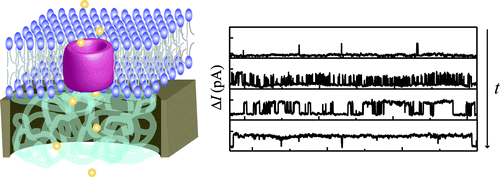-
Switching Transport through Nanopores with pH-Responsive Polymer Brushes for Controlled Ion Permeability
G.W. De Groot, M.G. Santonicola, K. Sugihara, T. Zambelli, E. Reimhult, J. Vörös and G.J. Vancso
ACS Applied Materials & Interfaces, 5 (4) (2013), p1400-1407


DOI:10.1021/am302820y | Abstract | Article HTML | Article PDF

Several nanoporous platforms were functionalized with pH-responsive poly(methacrylic acid) (PMAA) brushes using surface-initiated atom transfer radical polymerization (SI-ATRP). The growth of the PMAA brush and its pH-responsive behavior from the nanoporous platforms were confirmed by scanning electron microscopy (SEM), Fourier transform infrared (FTIR) spectroscopy, and atomic force microscopy (AFM). The swelling behavior of the pH-responsive PMAA brushes grafted only from the nanopore walls was investigated by AFM in aqueous liquid environment with pH values of 4 and 8. AFM images displayed open nanopores at pH 4 and closed ones at pH 8, which rationalizes their use as gating platforms. Ion conductivity across the nanopores was investigated with currentāvoltage measurements at various pH values. Enhanced higher resistance across the nanopores was observed in a neutral polymer brush state (lower pH values) and lower resistance when the brush was charged (higher pH values). By adding a fluorescent dye in an environment of pH 4 or pH 8 at one side of the PMAA-brush functionalized nanopore array chips, diffusion across the nanopores was followed. These experiments displayed faster diffusion rates of the fluorescent molecules at pH 4 (PMAA neutral state, open pores) and slower diffusion at pH 8 (PMAA charged state, closed pores) showing the potential of this technology toward nanoscale valve applications.






